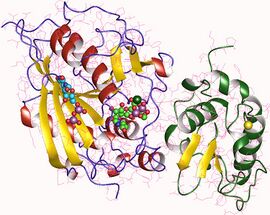Biology:Lactose synthase
| Lactose synthase | |||||||||
|---|---|---|---|---|---|---|---|---|---|
 Lactose synthase monomer, Bos taurus + alpha-lactalbumin (mouse) | |||||||||
| Identifiers | |||||||||
| EC number | 2.4.1.22 | ||||||||
| CAS number | 2604493 | ||||||||
| Databases | |||||||||
| IntEnz | IntEnz view | ||||||||
| BRENDA | BRENDA entry | ||||||||
| ExPASy | NiceZyme view | ||||||||
| KEGG | KEGG entry | ||||||||
| MetaCyc | metabolic pathway | ||||||||
| PRIAM | profile | ||||||||
| PDB structures | RCSB PDB PDBe PDBsum | ||||||||
| |||||||||
Lactose synthase is an enzyme that generates lactose from glucose and UDP-galactose.
It is classified under EC 2.4.1.22.
It consists of N-acetyllactosamine synthase and alpha-lactalbumin. Alpha-lactalbumin, which is expressed in response to prolactin, increases the affinity of N-acetyllactosamine synthase for its substrate, causing increased production of lactose during lactation.
N-acetyllactosamine synthase falls under the category of beta-1,4-galactosyltransferase, a type-II membrane protein found in the Golgi.[1][2] Alpha-lactalbumin is a Ca2+ binding protein specific to mammary glands. Beta-1,4-galactosyltransferase consists of the catalytic component and alpha-lactalbumin consists of the regulatory component of lactose synthase.[1] Alpha-lactalbumin promotes glucose binding to beta-1,4-galactosyltransferase.[1][2] The beta-1,4-galactosyltransferase catalytic component consists of two flexible loops: small loop and large loop. The small loop consists of a Trp residue (Trp314) with surrounding glycine residues, meanwhile the large loop makes up amino acid residues 345 to 365. The Trp residue in the small loop moves allowing for the sugar nucleotide to be locked into the binding site. This causes a conformational change in the large loop which then creates sites for oligosaccharide and metal ion binding, and protein-protein interactions for alpha-lactalbumin.[3]
References
- ↑ 1.0 1.1 1.2 "Crystal structure of lactose synthase reveals a large conformational change in its catalytic component, the beta1,4-galactosyltransferase-I". Journal of Molecular Biology 310 (1): 205–18. June 2001. doi:10.1006/jmbi.2001.4757. PMID 11419947.
- ↑ 2.0 2.1 Amado, M.; Almeida, R.; Schwientek, T.; Clausen, H. (1999-12-06). "Identification and characterization of large galactosyltransferase gene families: galactosyltransferases for all functions". Biochimica et Biophysica Acta (BBA) - General Subjects 1473 (1): 35–53. doi:10.1016/s0304-4165(99)00168-3. ISSN 0006-3002. PMID 10580128.
- ↑ Ramakrishnan, Boopathy; Boeggeman, Elizabeth; Qasba, Pradman K. (2002-03-15). "Beta-1,4-galactosyltransferase and lactose synthase: molecular mechanical devices". Biochemical and Biophysical Research Communications 291 (5): 1113–1118. doi:10.1006/bbrc.2002.6506. ISSN 0006-291X. PMID 11883930.
External links
- Lactose+synthase at the US National Library of Medicine Medical Subject Headings (MeSH)
 |

